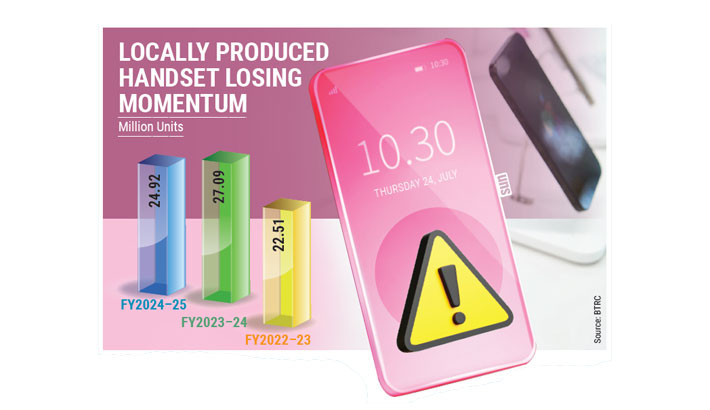Despite early optimism and rising smartphone production, Bangladesh’s local mobile phone manufacturing industry appears to be losing steam.
An analysis of official data over the last three fiscal years, FY2023 to FY2025, shows a downward trend in overall production, even as smartphone and 5G devices make modest gains.
Data from Bangladesh Telecommunication Regulatory Commission (BTRC) reveals Bangladesh’s local handset production dropped sharply, from 27.09 million units in FY2023-24 to 24.92 million units in FY2024-25, a decline of over 2.17 million units in just one year.
While FY2023-24 had signalled a post-pandemic rebound from the FY2022-23 slowdown, the fresh dip in FY2024-25 has reignited concerns about the industry’s long-term resilience, market saturation, and policy support.
Industry insiders point to a range of issues, including falling consumer demand, pricing challenges, and grey imports, as contributing factors.
In recent years, local phone manufacturers have raised alarms over the growing dominance of grey imports, which they say are eating into sales and weakening domestic production.
According to the Mobile Phone Industry Owners’ Association of Bangladesh (MIOB), nearly 40% of the smartphone market is now controlled by grey imports.
As these illegal handsets flood the market, local firms – already burdened by high input costs – are seeing their profit margins squeezed and competitiveness eroded.
“The handset industry is under growing pressure as illegal phones enter the country unchecked,” said Jakaria Shahid, President of MIOB.
The situation has worsened with a recent tax hike on locally assembled phones, pushing the effective rate to 35%, the highest in the region, compared to Pakistan’s 20%, he added.
Despite an overall industry slowdown, smartphones have steadily risen since Bangladesh began local manufacturing in 2017. Their share jumped from just over 25% of total production in FY2023 to nearly 40% in FY2024, peaking at almost 50% by June 2025.
This reflects a growing consumer shift toward smart devices, fueled by the rise of mobile banking, digital services, and app-driven lifestyles.
However, the rise in smartphones hasn’t been strong enough to offset the sector’s broader production slump.
“We’re seeing clear preference for smartphones, but affordability is still a major barrier,” said MN Nahid, an industry analyst with nearly a decade of experience in Bangladesh’s tech and smartphone ecosystem
“Inflation and weak purchasing power have slowed demand for mid-range and 5G-enabled models. Meanwhile, pre-owned and grey market phones are reshaping consumer behaviour and squeezing local manufacturers,” said Nahid.
He emphasised the need for policy support, better pricing strategies, and bolder localisation efforts to revive growth.
Despite all the talk around next-gen readiness, 5G handset production remains minimal. In FY2025, only a small fraction of locally produced phones were 5G-enabled – even in June, the peak month, the numbers were modest and far from transformative.
Meanwhile, the industry is grappling with a prolonged LC (Letter of Credit) crisis driven by the dollar shortage and exchange rate volatility. As a result, sales continue to fall, while the expanding grey market further undercuts local brands.
“High taxes, weak 4G service, and unaffordable entry-level smartphones are piling more pressure on local manufacturers,” said Jakaria Shahid, also managing director and founder of Edison Group.
Policy and enforcement gaps also remain a concern. The National Equipment Identity Register (NEIR), introduced by BTRC to stop illegal handset use, remains only partially implemented, making it ineffective in curbing grey imports.
At the same time, the market remains anchored to outdated technology. In FY2025, over 50% of handsets produced were still basic 2G feature phones, reflecting the sector’s deep reliance on low-end devices.
While this underscores the resilience of rural, low-income demand, it also exposes a deeper challenge: digital progress is being held back by affordability issues, poor infrastructure, and low digital literacy.



